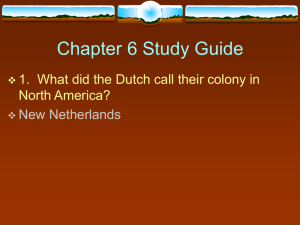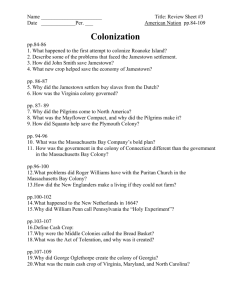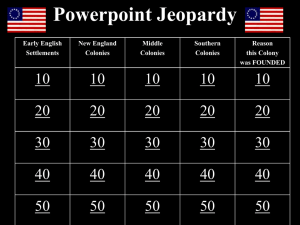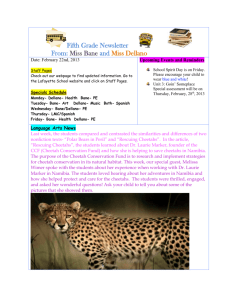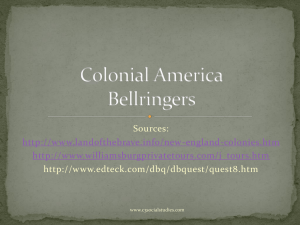Ch 2 England's Colonial Experiment (1590-1750)
advertisement
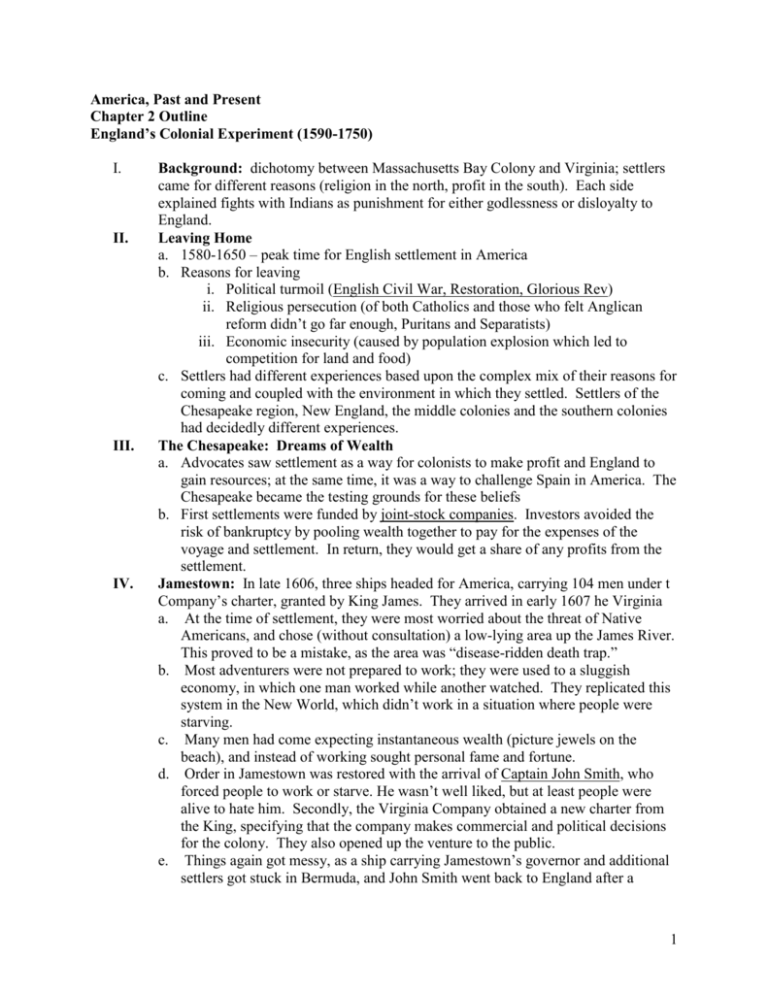
America, Past and Present Chapter 2 Outline England’s Colonial Experiment (1590-1750) I. II. III. IV. Background: dichotomy between Massachusetts Bay Colony and Virginia; settlers came for different reasons (religion in the north, profit in the south). Each side explained fights with Indians as punishment for either godlessness or disloyalty to England. Leaving Home a. 1580-1650 – peak time for English settlement in America b. Reasons for leaving i. Political turmoil (English Civil War, Restoration, Glorious Rev) ii. Religious persecution (of both Catholics and those who felt Anglican reform didn’t go far enough, Puritans and Separatists) iii. Economic insecurity (caused by population explosion which led to competition for land and food) c. Settlers had different experiences based upon the complex mix of their reasons for coming and coupled with the environment in which they settled. Settlers of the Chesapeake region, New England, the middle colonies and the southern colonies had decidedly different experiences. The Chesapeake: Dreams of Wealth a. Advocates saw settlement as a way for colonists to make profit and England to gain resources; at the same time, it was a way to challenge Spain in America. The Chesapeake became the testing grounds for these beliefs b. First settlements were funded by joint-stock companies. Investors avoided the risk of bankruptcy by pooling wealth together to pay for the expenses of the voyage and settlement. In return, they would get a share of any profits from the settlement. Jamestown: In late 1606, three ships headed for America, carrying 104 men under t Company’s charter, granted by King James. They arrived in early 1607 he Virginia a. At the time of settlement, they were most worried about the threat of Native Americans, and chose (without consultation) a low-lying area up the James River. This proved to be a mistake, as the area was “disease-ridden death trap.” b. Most adventurers were not prepared to work; they were used to a sluggish economy, in which one man worked while another watched. They replicated this system in the New World, which didn’t work in a situation where people were starving. c. Many men had come expecting instantaneous wealth (picture jewels on the beach), and instead of working sought personal fame and fortune. d. Order in Jamestown was restored with the arrival of Captain John Smith, who forced people to work or starve. He wasn’t well liked, but at least people were alive to hate him. Secondly, the Virginia Company obtained a new charter from the King, specifying that the company makes commercial and political decisions for the colony. They also opened up the venture to the public. e. Things again got messy, as a ship carrying Jamestown’s governor and additional settlers got stuck in Bermuda, and John Smith went back to England after a 1 V. gunshot wound. 1609-1611 was known as the “Starving Time.” Additionally, the Powhatan people and English did not peacefully coexist; their views on property and land use differed to greatly. Remaining settlers resorted to cannibalism, and left to return home, luckily they were intercepted by Governor De La Waar’s ship, and returned to Jamestown with more men and now women too. f. The colony may have survived at this point, but never would have made a profit, if it weren’t for the “stinking weed.” John Rolfe, who had married Chief Powhatan’s daughter Pocahantas, experimented with the Indian tobacco crop, creating a milder version that appealed to Europeans. Virginians began to plant tobacco everywhere, and the king, initially opposed to the vice, and allowed it because of the profit the Company would make. g. Under Sir Edwin Sandys, the Company made a number of reforms, including creating the House of Burgesses, a representative assembly in VA that first met in 1619. He also came up with the headright system, which gave adventurers a 50acre plot of land for each themselves and each servant they brought over, provided they covered their own transportation costs. This created a rise in indentured servitude, most of whom came over as teenage boys to work under contract for a certain number of years (few outlived their contract). Diseased killed over half the colonists, even in relatively good times. h. King Charles I was embarrassed by Jamestown, and made the charter a royal one, appointing the governor and council himself. Though he dissolved the House of Burgesses, they continued to meet and in 1639 the body was officially recognized. In 1634, the body divided VA into eight counties, each had a “county court,” which convened as a governing body and a court. i. Daily life in VA was centered on work on one’s own land. People were isolated and there were no population centers besides Jamestown. Maryland: first settled in 1634, after push from Sir George Calvert (later Lord Baltimore), Maryland flourished as a tobacco colony and a place of religion toleration. a. in 1632, King Charles I granted a royal charter for Calvert’s son in what is now Maryland (named for the queen). Cecilius (the second Lord Baltimore) wanted to found a colony for England’s persecuted Catholics and for profit. b. The first Lord Baltimore set up a charter that resembled a feudal hierarchy, with himself at the top. The settlers, who began arriving in 1634, had no interest. They also feuded with him regarding the elected assembly; Baltimore only wanted them to discuss only acts he had prepared. c. Protestants, who had joined Catholics in settlement, became uneasy following the English Civil War. To placate them, the famous Act Concerning Religion was created in 1649, which extended religious toleration to all accepted the divinity of Christ. The act was landmark, but also temporary, repealed when Puritans seized the colonies government. d. Majority of Maryland’s settlers were tobacco planters, living in a manner that was quite substandard to what they have left in England. 2 VI. New England: Plymouth Plantation and Massachusetts Bay Colony a. Pilgrims (who wished to separate from the English church) came to America after a temporary stay in the Netherlands aboard the Mayflower in 1620. They had intended to settle in Virginia, but an error in navigation led them to New England. b. Since they had a patent to settle in Virginia, it wouldn’t be valid; they drafted the Mayflower Compact while aboard, an agreement to form a government, “combine our selves together into a civil body politick.” c. Times were rough at first; half of the original 121 settlers died of disease or hunger. William Bradford was the John Smith of the Plymouth Plantation, though he had a lot of help from Squanto, a local Native American who had lived in England for a time. d. Eventually, the small farm communities of Plymouth were absorbed by the Massachusetts Bay Colony (1691). e. Back in England, Puritans, who believed in predestination and wished to purify the Anglican Church, were alienated by Charles I, who advanced William Laud, a bishop who stood for everything Puritans hated. f. In 1630, John Winthrop, a leading Puritan, and others set out to create a “City Upon a Hill.” The first settlers survived; the sex ratio was more balanced, there was clean drinking water, and a healthy climate. i. They believed that God had formed a covenant with the people of Massachusetts, and their job was to create a society that would serve as a beacon to the rest of the Christian world. This belief led to a strong work ethic, and a strong sense of community. ii. Though they never fully separated from the Church of England, they formed their own kind of church government, Congregationalism, each village church operated independent of outside influence. To be a member, a person had to perform a confession of faith before neighbors who were already members. g. Because any church-going male could vote, the MBC had a strong franchise; at least 40% of males could vote during the 1630s. i. The colonial government was neither a theocracy nor a democracy. The elected magistrates in Massachusetts ruled in the name of the electorate, but their responsibility was to God. ii. Congregational ministers had no formal political authority. h. Puritans, though interested in their own religious freedom, had little tolerance for dissent, i. Roger Williams, who arrived in the colony in 1631, preached extreme separatism, and believed that the Bay Colonists didn’t legitimately hold the land, as they had not purchased it from area Indians. He also believed that people shouldn’t be punished by civil leaders for religious beliefs. He was eventually banished from the colony, and founded Rhode Island. ii. Anne Hutchinson, who arrived in 1634, believed that the Puritan church leaders were little better than Laud in England. She too was exiled to Rhode Island. i. Settlement followed in… i. New Hampshire, 1623, economically dependent on Massachusetts 3 ii. Connecticut, 1636, Thomas Hooker, the most prominent minister, defined Congregational church polity, and CT representatives passed the Fundamental Orders, a blueprint for civil government. iii. New Haven, absorbed by CT in 1662 iv. Rhode Island, 1636, open society that drew independent minded people VII. Diversity in the Middle Colonies: Each colony developed heterogeneous population, religiously, ethnically, and politically (foreshadowing in America) a. New York was originally New Amsterdam, settled by the Dutch after an English explorer, Henry Hudson, explored the area for the Dutch. First settlers were employees, and a very diverse population followed, including free blacks. b. The English sent in their Navy to seize the colony, and the Dutch didn’t resist, though their last director-general, Peter Stuyvesant, urged them to resist. c. Charles II granted to colony to his brother, the Duke of York, who passed the Duke’s Laws, which granted religious toleration and set up local governments. However, their was no representative body, and New York remained diverse, loosely collected, independent communities. d. New Jersey was awarded to Berkeley and Carteret by the Duke of York, but controversy remained, as British Colonel Nicolls believed he held the territory (actually, the king had the final say). Berkeley got fed up with the fighting and sold his portion to some Quakers, who fought amongst themselves. The colony lacked its own deep water harbor, and never could compete with New York. e. Pennsylvania was settled by Quakers (Professors of the Light, Friends). They believed that there was no need for learned ministry, as one person’s interpretation of scripture was as valid as anyone’s, this was a liberating belief, especially for lower-class English. Quakers preached conversion constantly. i. Charles II granted a charter to William Penn, who launched his “Holy Experiment in Pennsylvania in 1681. ii. In his “Frame of Government,” Penn guaranteed that settlers would enjoy liberty of conscience, freedom from persecution, no taxation without representation, and due process of law. He drew his ideas from James Harrington, and English political philosopher. iii. Most settlers were Irish, Welsh and English Quakers, but Penn opened the colony up to all nations, and a diverse population developed. Most were farmers, and wheat was especially in demand. iv. In 1701, Penn signed the Charter of Liberties, which created a unicameral legislature with the power to initiate bills (the only one in colonial America) v. Delaware was originally part of this land grant, and became a separate colony in 1703. 4 VIII. The Carolinas: started as a commercial venture, but recruitment efforts failed. a. In 1669, Anthony Ashley Cooper convinced remaining proprietors to invest their own money. This got things going. John Locke helped him draft the Fundamental Constitutions of Carolina, and Cooper was also influenced by Harrington (he hoped to balance democracy and aristocracy). b. At first ½ of the settlers in the Carolinas came from Barbados (which had become overpopulated), and they brought their slaves and plantation style with them. French Huguenots came later, and the colony was very divided. South Carolina became its own colony in 1729. c. Crops were tobacco, silk, grapes, beef, skins, naval stores, and later rice. IX. Georgia: James Oglethorpe saw Georgia as a way to thwart Spain from taking the area; they controlled Florida, and England and Spain fought constantly at this time. He also intended to populate the area with England’s worthy poor, as an alternative to debtor’s prison. a. In 1732, the king granted Oglethorpe a charter. Few settlers were attracted, as there were strict rules (no slaves, no rum). Oglethorpe, however, lost interest after a failed attempt to capture St. Augustine from the Spanish. His trustees compromised, and Georgia became a hard-drinking slave-owning colony, which still attracted few settlers. 5
